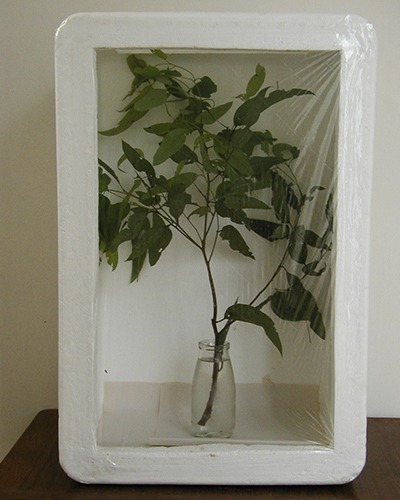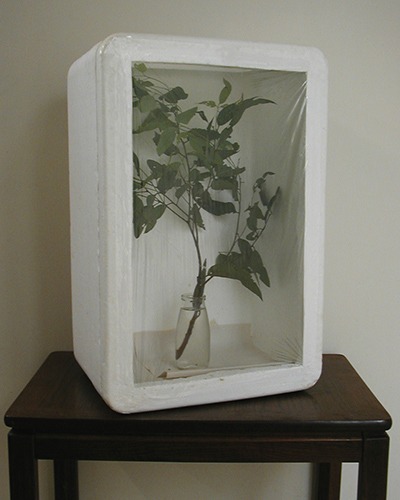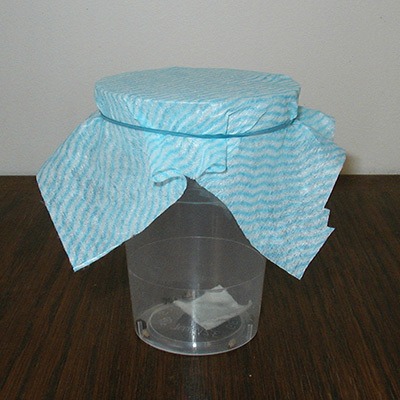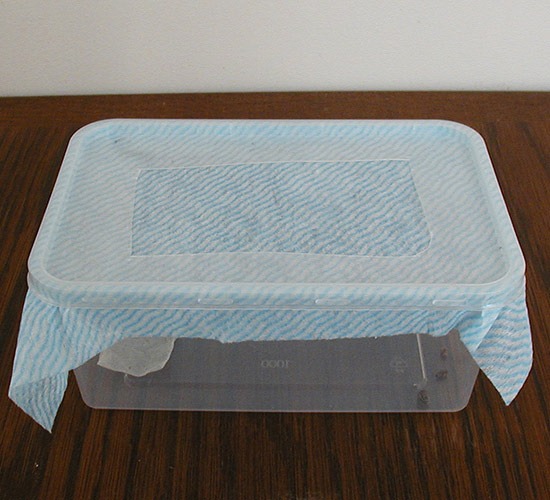Rearing Stick Insects
Stick insects make amazing pets. They are large, easy to care for and most can be gently handled. Read the instructions and tips below to learn how to care for stick insects. Please note that these instructions are suitable for the species of stick insects covered in the fact sheets or that you may find around South East Queensland. Other species will have their own dietary requirements, so if you have purchased stick insects from another source, be sure to refer to the care instructions your breeder has given you.
Stick Insect Accomodation
Stick insect nymphs are very active and need a secure enclosure to prevent escape. The enclosure must be fairly tall (at least 50cm) to allow room for growth and moulting. Try one of the following set ups:
- Styrofoam box (see picture below or the Make Your Own Bug Box Fact Sheet).
- Aquarium – stand the aquarium on its end and cover the front with fine mesh.

© Mount Glorious Biological Centre

© Mount Glorious Biological Centre
Feeding Stick Insects
Nymphs should be provided with tender foliage of Eucalyptus (gum leaves), which needs to be replaced every five to seven days. Eucalypts can be distinguished from other plants such as wattles by their sickle shaped or blade-like leaf with a single vein running down the centre. Place long stems of the plant in a vase of water and place inside the enclosure. Eucalyptus can soak up a lot of water, so check the vase daily and top up when needed. As long as they have a ready supply of fresh leaves, the insects require no other source of water.
When replacing plant, gently move the nymphs onto the new foliage (See tips below for correct handling). But be careful! These insects are masters of disguise and it is quite easy to throw them out with the old plant. Make sure you do a head count at the end!
Try a few different types of Eucalypt, to see which one the stick insects prefer. If you are unsure if your stick insects are eating the plant, place a sheet of white paper under the vase for the day. The presence of droppings indicates that they are feeding.
Nymphs will shed their skin (known as moulting) 5 times during their life. During this process, the old skin is shed, leaving a new, larger skin, which provides them with the room they need to grow. The new skin takes a while to harden and nymphs should not be handled during this time.
Some species of Australian stick insects may grow to an adult length of 20 to 30cm. The time for these insects to reach this stage may take several weeks or months, depending on temperature, humidity and the quality of the food plant.
Stick Insect Eggs
If you have an adult female stick insect you will almost certainly have them lay lots of eggs for you over time. If you have a local species (check out my stick insect fact sheets to work out where your stick insects naturally occur), these eggs can be released into the garden. If you have purchased something that does not naturally occur in your area, you should not release eggs or nymphs into the wild as they can interfere with native plants and animals in your neighbourhood. If you do have lots of eggs, try contacting the breeder you purchased them from to see if they will take them off your hands. Alternatively, you can freeze eggs for a few days to render them unviable.
If you are keeping a local species follow the instructions below to ensure the eggs hatch.
- Store the eggs in a large container, to give the hatching nymphs plenty of room to emerge. Plastic takeaway food containers or a clear plastic drinking cup are good options (see pictures below). Make sure the new containers have secure lids and ventilation. A hole can be cut into the lids of containers and a piece of fine mesh, nappy liner or chux cleaning cloth, secured over the container before replacing the lid. If a drinking cup is used, a circle of the above materials can be secured over the top with a rubber band.
- A small piece (approx. the size of a 5c coin) of moistened tissue can be placed in the container to prevent the eggs from drying out. Be careful not to make the container too wet, as mould will develop on the eggs.
Please note: You can’t predict exactly when a stick insect egg will hatch. They wait for the perfect combination of temperature and humidity before they emerge, so it’s up to Mother Nature. They can sometimes take several months or even a year to hatch, so you’ll need to be patient.

© Mount Glorious Biological Centre

© Mount Glorious Biological Centre
Handling Stick Insects
Stick insects are completely harmless and are lots of fun to handle. Follow these tips to ensure you don’t hurt your stick insects.
- Try to get the stick insect to crawl onto you, by placing your hand in its path. Forcefully moving stick insects from foliage or clothing can cause them to lose limbs.
- Stick insects usually want to climb upwards
- Take care when handling winged adults, as they are inclined to take flight
- Be careful not to handle moulting or newly moulted stick insects, as they are very delicate during this period.
Having problems? Have a look at our Frequently Asked Questions about Stick Insects below.
Frequently Asked Questions

